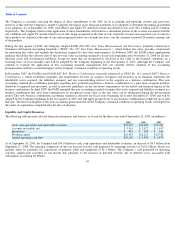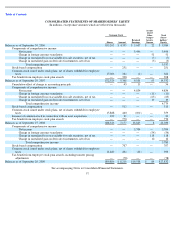Apple 2009 Annual Report Download - page 55
Download and view the complete annual report
Please find page 55 of the 2009 Apple annual report below. You can navigate through the pages in the report by either clicking on the pages listed below, or by using the keyword search tool below to find specific information within the annual report.
Table of Contents
individuals in connection with related legal proceedings. It is not possible to determine the maximum potential amount of payments the
Company could be required to make under these agreements due to the limited history of prior indemnification claims and the unique facts and
circumstances involved in each claim. However, the Company maintains directors and officers liability insurance coverage to reduce its
exposure to such obligations, and payments made under these agreements historically have not materially adversely affected the Company’
s
financial condition or operating results.
Interest Rate and Foreign Currency Risk Management
The Company regularly reviews its foreign exchange forward and option positions, both on a stand-
alone basis and in conjunction with its
underlying foreign currency and interest rate related exposures. However, given the effective horizons of the Company’
s risk management
activities and the anticipatory nature of the exposures, there can be no assurance the hedges will offset more than a portion of the financial
impact resulting from movements in either foreign exchange or interest rates. In addition, the timing of the accounting for recognition of gains
and losses related to mark-to-
market instruments for any given period may not coincide with the timing of gains and losses related to the
underlying economic exposures and, therefore, may adversely affect the Company’s financial condition and operating results.
Interest Rate Risk
While the Company is exposed to interest rate fluctuations in many of the world’s leading industrialized countries, the Company’
s interest
income and expense is most sensitive to fluctuations in the general level of U.S. interest rates. As such, changes in U.S. interest rates affect the
interest earned on the Company’
s cash, cash equivalents and marketable securities, the fair value of those investments, as well as costs
associated with foreign currency hedges.
The Company’
s investment policy and strategy are focused on preservation of capital and supporting the liquidity requirements of the Company.
A portion of the Company’s cash is managed by external managers within the guidelines of the Company’
s investment policy and to objective
market benchmarks. The Company’s internal portfolio is benchmarked against external manager performance.
The Company’s exposure to market risk for changes in interest rates relates primarily to the Company’
s investment portfolio. The Company
typically invests in highly rated securities and its policy generally limits the amount of credit exposure to any one issuer. The Company’
s
investment policy requires investments to be investment grade, primarily rated single-
A or better with the objective of minimizing the potential
risk of principal loss. All highly liquid investments with initial maturities of three months or less at the date of purchase are classified as cash
equivalents. The Company classifies its marketable securities as either short-term or long-term based on each instrument’
s underlying
contractual maturity date. All short-term marketable securities have maturities less than 12 months, while all long-
term marketable securities
have maturities ranging from one to five years. The Company may sell its investments prior to their stated maturities for strategic purposes, in
anticipation of credit deterioration, or for duration management. The Company recognized no material net gains or losses during 2009, 2008 and
2007 related to such sales.
To provide a meaningful assessment of the interest rate risk associated with the Company’
s investment portfolio, the Company performed a
sensitivity analysis to determine the impact a change in interest rates would have on the value of the investment portfolio assuming a 100 basis
point parallel shift in the yield curve. Based on investment positions as of September 26, 2009, a hypothetical 100 basis point increase in interest
rates across all maturities would result in a $176 million incremental decline in the fair market value of the portfolio. As of September 27, 2008,
a similar 100 basis point shift in the yield curve would have resulted in a $46 million incremental decline in the fair market value of the portfolio.
Such losses would only be realized if the Company sold the investments prior to maturity.
52
Item 7A.
Quantitative and Qualitative Disclosures About Market Risk
























